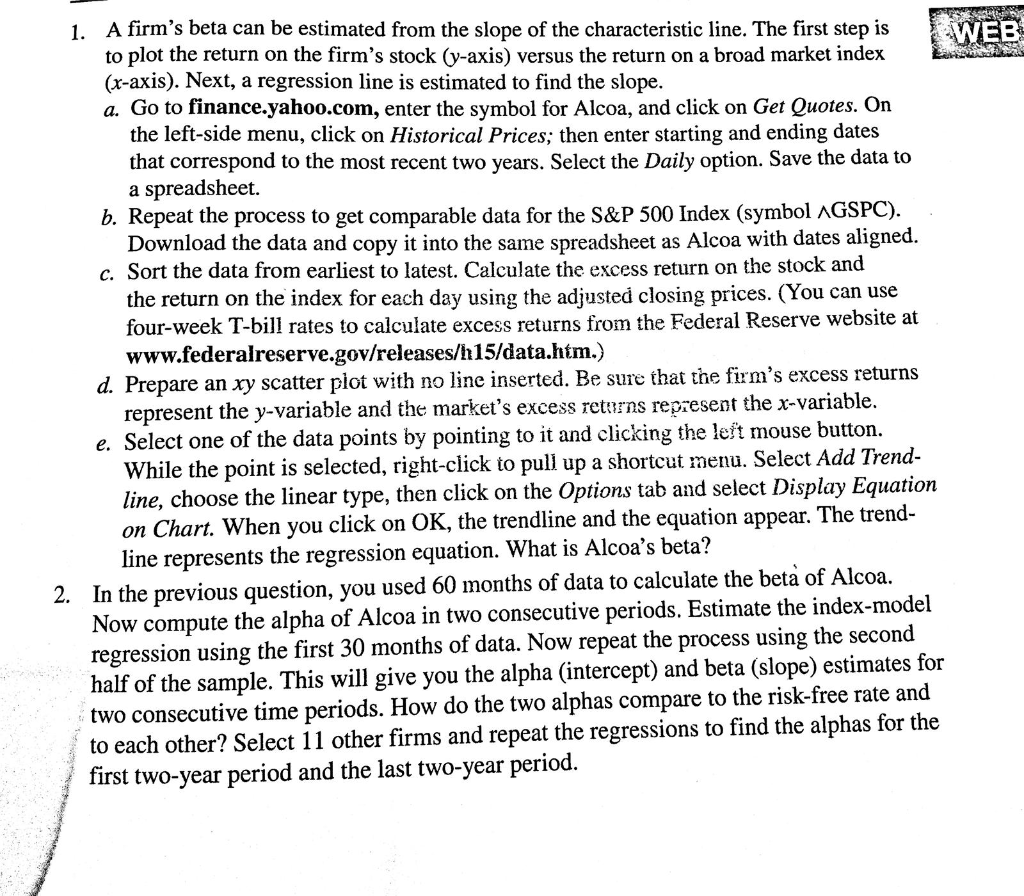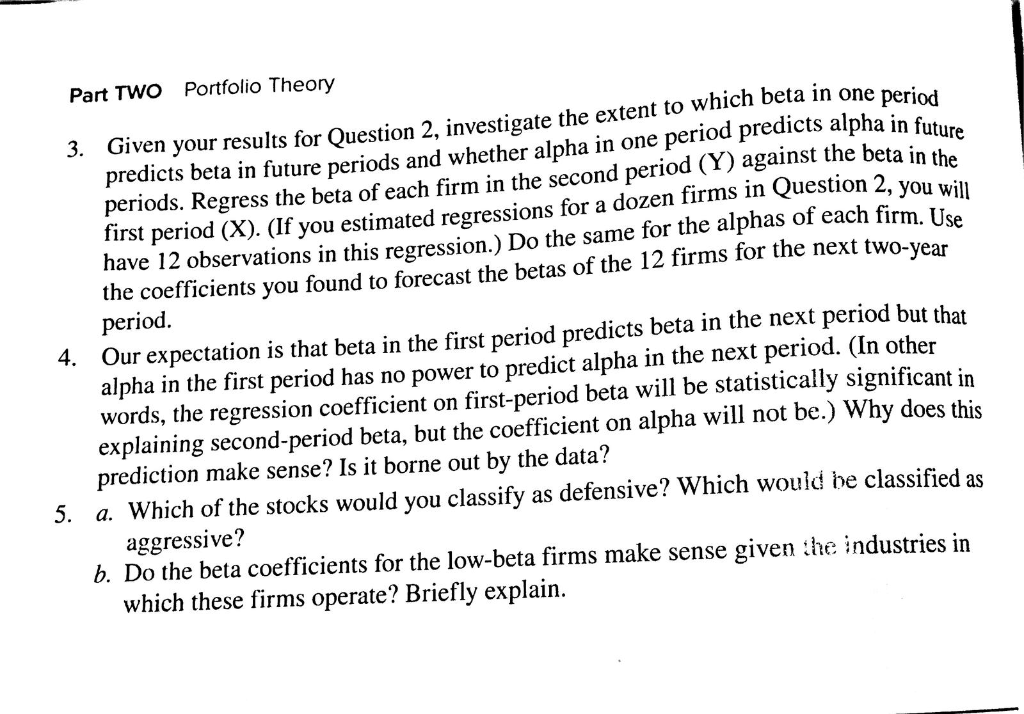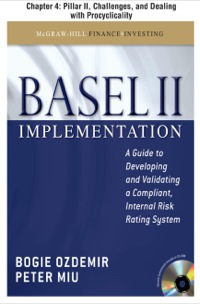

A firm's beta can be estimated from the slope of the characteristic line. The first step is to plot the return on the firm's stock (y-axis) versus the return on a broad market index (x-axis). Next, a regression line is estimated to find the slope a. Go to finance.yahoo.com, enter the symbol for Alcoa, and click on Get Quotes. On WEB 1. the left-side menu, click on Historical Prices; then enter starting and ending dates that correspond to the most recent two years. Select the Daily option. Save the data to a spreadsheet. b. Repeat the process to get comparable data for the S&P 500 Index (symbol AGSPC). Download the data and copy it into the same spreadsheet as Alcoa with dates aligned. c. Sort the data from earliest to latest. Calculate the excess return on the stock and the return on the index for each day using the adjusted closing prices. (You can use four-week T- rates to calculate excess returns from the Federal Reserve website at www.federalreserve.gov/releases/h15/data.htm.) pare an xy scatter piot with no line inserted. Be sure that the firm's excess returns d. Pre represent the y-variable and the market's excess returns represent the x-variable. e. Select one of the data points by pointing to it and clicking the left mouse button. While the point is selected, right-click to pull up a shortcuti ct Display Equation line, choose the linear type, then click on the Options tab and sele the trendline and the equation appear. The trend- on Chart. When you click on OK, line represents the regression equation. What is Alcoa's beta? e previous question, you used 60 months of data to calculate the beta of Alcoa. Now compute the alpha of Alcoa in two consecutive periods. Estimate the index-model regression using the first 30 months of data. Now repeat the process using the second half of the sample. This will give you the alpha (intercept) and beta (slope) estimates for two consecutive time periods. How do the two alphas compare to the risk-free rate and to each other? Select 11 other firms and repeat the regressions to find the alphas for the first two-year period and the last two-year period 2. In th Portfolio Theory Part TWO Given your results for Question 2, investigate the extent to which beta in one period predicts beta in future periods and whether alpha in one period predicts alpha in f periods. Regress the beta of each firm in the second period (Y) against the beta in 3. the beta in the ion 2, you will first irst period (X). (If you estimated regressions for a dozen firms in Question 2, you 12 observations in this regression.) Do the same for the alphas of each firm. Use the coefficients you found to forecast the betas of the 12 firms for the next two-year period. 4. Our expectation is that beta in the first period predicts beta in the next period but that alpha in the first period has no power to predict alpha in the next period. (In other words, the regression coefficient on first-period beta will be statistically significant in explaining second-period beta, but the coefficient on alpha will not be.) Why does this prediction make sense? Is it borne out by the data? a. Which of the stocks would you classify as defensive? Which would be classified as 5. aggressive? b. Do the beta coefficients for the low-beta firms make sense given the industries in which these firms operate? Briefly explain A firm's beta can be estimated from the slope of the characteristic line. The first step is to plot the return on the firm's stock (y-axis) versus the return on a broad market index (x-axis). Next, a regression line is estimated to find the slope a. Go to finance.yahoo.com, enter the symbol for Alcoa, and click on Get Quotes. On WEB 1. the left-side menu, click on Historical Prices; then enter starting and ending dates that correspond to the most recent two years. Select the Daily option. Save the data to a spreadsheet. b. Repeat the process to get comparable data for the S&P 500 Index (symbol AGSPC). Download the data and copy it into the same spreadsheet as Alcoa with dates aligned. c. Sort the data from earliest to latest. Calculate the excess return on the stock and the return on the index for each day using the adjusted closing prices. (You can use four-week T- rates to calculate excess returns from the Federal Reserve website at www.federalreserve.gov/releases/h15/data.htm.) pare an xy scatter piot with no line inserted. Be sure that the firm's excess returns d. Pre represent the y-variable and the market's excess returns represent the x-variable. e. Select one of the data points by pointing to it and clicking the left mouse button. While the point is selected, right-click to pull up a shortcuti ct Display Equation line, choose the linear type, then click on the Options tab and sele the trendline and the equation appear. The trend- on Chart. When you click on OK, line represents the regression equation. What is Alcoa's beta? e previous question, you used 60 months of data to calculate the beta of Alcoa. Now compute the alpha of Alcoa in two consecutive periods. Estimate the index-model regression using the first 30 months of data. Now repeat the process using the second half of the sample. This will give you the alpha (intercept) and beta (slope) estimates for two consecutive time periods. How do the two alphas compare to the risk-free rate and to each other? Select 11 other firms and repeat the regressions to find the alphas for the first two-year period and the last two-year period 2. In th Portfolio Theory Part TWO Given your results for Question 2, investigate the extent to which beta in one period predicts beta in future periods and whether alpha in one period predicts alpha in f periods. Regress the beta of each firm in the second period (Y) against the beta in 3. the beta in the ion 2, you will first irst period (X). (If you estimated regressions for a dozen firms in Question 2, you 12 observations in this regression.) Do the same for the alphas of each firm. Use the coefficients you found to forecast the betas of the 12 firms for the next two-year period. 4. Our expectation is that beta in the first period predicts beta in the next period but that alpha in the first period has no power to predict alpha in the next period. (In other words, the regression coefficient on first-period beta will be statistically significant in explaining second-period beta, but the coefficient on alpha will not be.) Why does this prediction make sense? Is it borne out by the data? a. Which of the stocks would you classify as defensive? Which would be classified as 5. aggressive? b. Do the beta coefficients for the low-beta firms make sense given the industries in which these firms operate? Briefly explain








